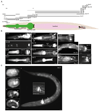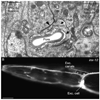High resolution map of Caenorhabditis elegans gap junction proteins
- PMID: 19621339
- PMCID: PMC2732576
- DOI: 10.1002/dvdy.22025
High resolution map of Caenorhabditis elegans gap junction proteins
Erratum in
-
High resolution map of caenorhabditis elegans gap junction proteins.Dev Dyn. 2015 Jul;244(7):903. doi: 10.1002/dvdy.24287. Dev Dyn. 2015. PMID: 26112952 No abstract available.
Abstract
The innexin family of gap junction proteins has 25 members in Caenorhabditis elegans. Here, we describe the first high-resolution expression map of all members through analysis of live worms transformed with green fluorescent protein under the control of entire promoter regions. Our analyses show that innexins have dynamic expression patterns throughout development and are found in virtually all cell types and tissues. Complex tissues, such as the pharynx, intestine, gonad, as well as scaffolding tissues and guidepost cells express a variety of innexins in overlapping or complementary patterns, suggesting they may form heteromeric and heterotypic channels. Innexin expression occurs in several types of cells that are not known to form gap junctions as well as in a pair of migrating cells, suggesting they may have hemichannel function. Therefore, innexins likely play roles in almost all body functions, including embryonic development, cell fate determination, oogenesis, egg laying, pharyngeal pumping, excretion, and locomotion.
Copyright (c) 2009 Wiley-Liss, Inc.
Figures





References
-
- Albertson DG, Thomson JN. The pharynx of Caenorhabditis elegans. Philos Trans R Soc Lond B Biol Sci. 1976;275:299–325. - PubMed
-
- Aurelio O, Hall DH, Hobert O. Immunoglobulin-domain proteins required for maintenance of ventral nerve cord organization. Science. 2002;295:686–690. - PubMed
-
- Avery L, Horvitz HR. Pharyngeal pumping continues after laser killing of the pharyngeal nervous system of C. elegans. Neuron. 1989;3:473–485. - PubMed
-
- Barbe MT, Monyer H, Bruzzone R. Cell-cell communication beyond connexins: the pannexin channels. Physiology (Bethesda) 2006;21:103–114. - PubMed
Publication types
MeSH terms
Substances
Grants and funding
LinkOut - more resources
Full Text Sources
Research Materials
Miscellaneous

